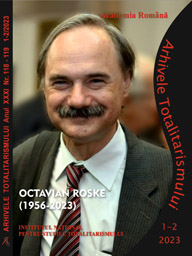Carol al II-lea. Ascensiunea autoritarismului și naționalismului monarhic 1934-1937, I
Carol II of Romania: The Rise of Monarchic Authoritarianism and Nationalism, 1934-1937, I
Author(s): Doru A LixandruSubject(s): History, Recent History (1900 till today), Special Historiographies:, Interwar Period (1920 - 1939), Fascism, Nazism and WW II
Published by: Institutul National pentru Studiul Totalitarismului
Keywords: King Carol II of Romania; authoritarian regime; interwar Romania; intellectuals; culture; propaganda;
Summary/Abstract: This study emphasizes the political and ideological path of the monarchist movement from 1934 to 1937. Now the Liberals rule in a veritable condominium with the king, whose influence is constantly growing. In fact, the period between 1934 and 1937 not only precede, but also prepare the regime change of February 1938. Without a prior rise in the popularity and power of Charles the Second, the establishment of an authoritarian monarchist regime would have been unlikely. In the first part of the study I explore how the followers of Charles the Second perceive the relationship between the capital and the regions of Greater Romania, respectively between Bucharest and the new provinces, and then I analyse the manner in which the process of personalization of power occurs (by reference to the King). In this regard, I examine one of the most circulated hypostases of the sovereign, namely that of "King of the peasants". Subsequently, I try to highlight the usefulness of social engineering's concept in investigating the ideas and reform practices promoted by the monarch and the followers of Charles the Second, then I analyse the monarchical initiatives aimed at national culture and Romanian youth.
Journal: Arhivele Totalitarismului
- Issue Year: XXXI/2023
- Issue No: 1-2
- Page Range: 56-87
- Page Count: 32
- Language: Romanian
- Content File-PDF

